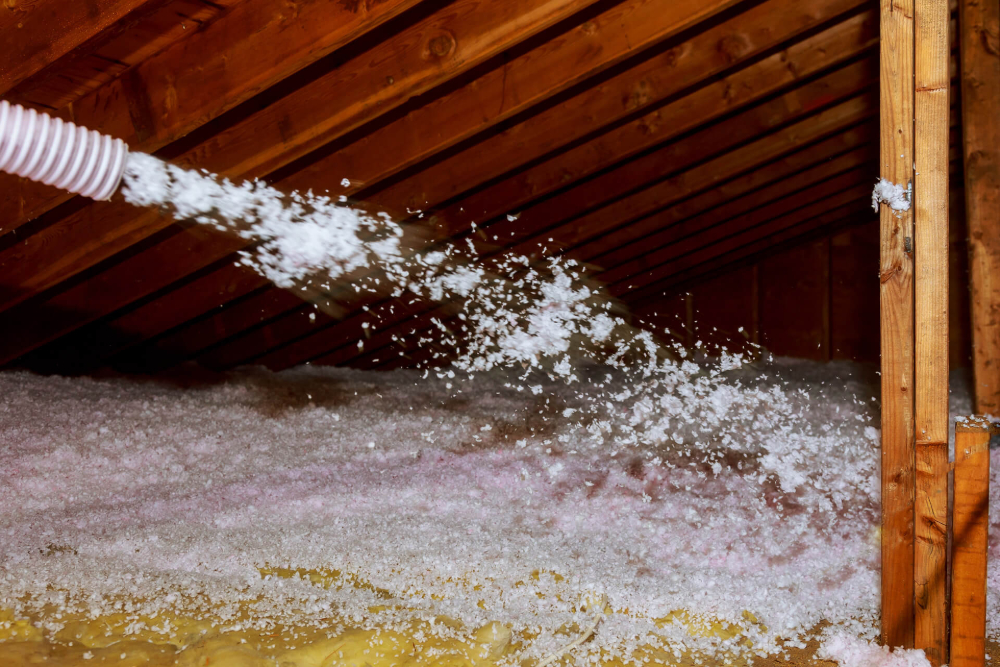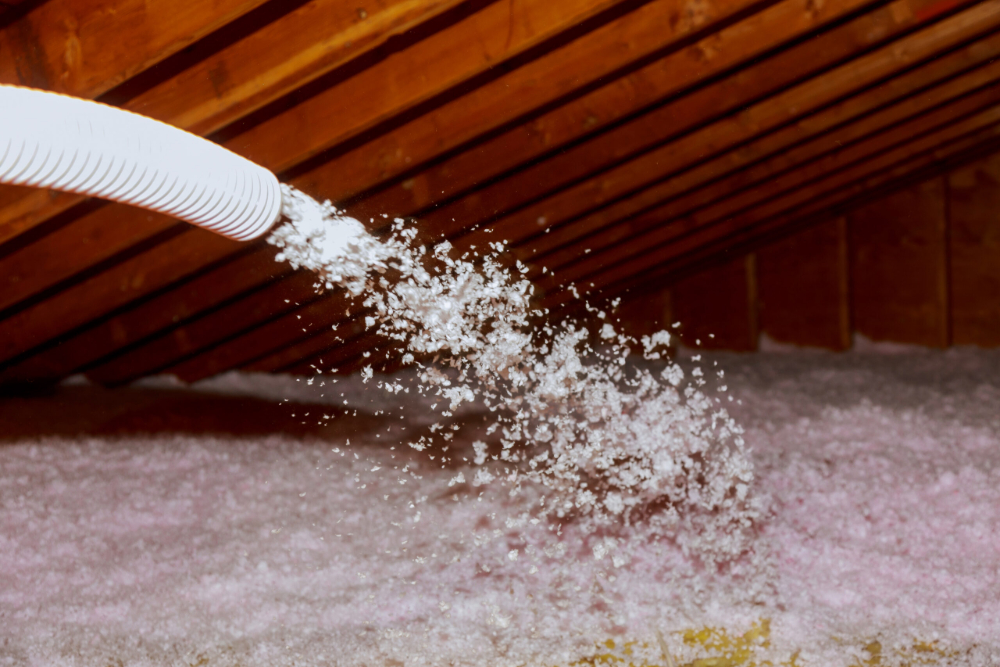Attic Insulation
Attic Insulation Services
Attic insulation is an essential component of any home’s energy efficiency. It is an easy and cost-effective way to reduce energy costs, increase comfort, and help protect the environment. Blown-in insulation, also known as loose-fill insulation, is a type of insulation that is applied by blowing or spraying loose insulation materials into a space. It can be made of different materials such as cellulose and fiberglass, and it is often used to insulate attics, walls, and other hard-to-reach areas in homes and buildings.
We prioritize quality workmanship, transparent pricing, and your complete satisfaction!
Benefits of Attic Insulation
Reduced Energy Costs
One of the most significant benefits of attic insulation is the reduction in energy costs. Attics can be a significant source of energy loss, especially in older homes. Without proper insulation, warm air can escape in the winter, and cool air can escape in the summer. This means that your heating and cooling systems have to work harder to maintain a comfortable temperature, leading to increased energy consumption and higher utility bills.
Attic insulation acts as a barrier, preventing the transfer of heat between the inside and outside of your home. By keeping your home’s temperature stable, your heating and cooling systems won’t have to work as hard to maintain it. This leads to lower energy consumption and reduced energy bills.
Increased Comfort
Another benefit of attic insulation is increased comfort. A properly insulated attic can help maintain a more consistent temperature throughout your home, reducing hot and cold spots. This can make your home more comfortable to live in, especially during extreme weather conditions.
Home Protection From Moisture
Proper attic insulation can help to prevent moisture buildup by regulating temperature and humidity levels. This can help to keep your home dry and free from mold and mildew growth, reducing the risk of damage to your home and your health.
Increased Home Value
Investing in attic insulation can also increase your home’s value. Potential buyers are often looking for homes that are energy-efficient and have lower utility bills. By investing in attic insulation, you are making your home more attractive to potential buyers, which can increase its value.
Frequently Asked Questions
General Questions
Why is attic insulation important?
Proper attic insulation is crucial for energy efficiency in your home. It creates a thermal barrier that prevents heat transfer—keeping warm air inside during winter and outside during summer. This significantly reduces your energy consumption, lowers utility bills, improves comfort by eliminating cold spots, and extends the lifespan of your HVAC system by reducing its workload.
How do I know if my attic needs new insulation?
Signs that your attic may need new insulation include high energy bills, uneven temperatures throughout your home, rooms that are too hot in summer or too cold in winter, ice dams on your roof during winter, or if your existing insulation appears compressed, damaged, moldy, or is less than 10-14 inches deep. A professional energy audit can definitively determine if your insulation needs upgrading.
How long does attic insulation last?
Most attic insulation materials have a lifespan of 15-30 years, but this varies based on the type of insulation, installation quality, environmental conditions, and whether it has been damaged by moisture, pests, or other factors. Regular inspections every 5-7 years are recommended to ensure your insulation is performing effectively.
Types of Insulation
What types of attic insulation do you offer?
We offer several types of attic insulation to meet different needs and budgets…
- Fiberglass batts: Pre-cut panels that fit between joists
- Blown-in fiberglass: Loose-fill insulation that conforms to all spaces
- Cellulose: Eco-friendly option made from recycled paper products
- Spray foam: Highest R-value option that creates an air seal
- Mineral wool: Fire-resistant option with sound-dampening properties
We’ll recommend the best option based on your specific home requirements and goals.
What is R-value and why does it matter?
R-value measures insulation’s thermal resistance—its ability to resist heat flow. The higher the R-value, the better the insulation performs. In most climate zones, attics should have insulation between R-38 and R-60 (about 10-20 inches depending on the material). Local building codes specify minimum R-values for your region, but we often recommend exceeding these minimums for optimal energy savings.
Is spray foam insulation worth the higher cost?
Spray foam insulation, while more expensive initially, often provides better long-term value for many homeowners. It creates both an air barrier and thermal barrier (unlike other insulations that only provide the latter), has the highest R-value per inch, prevents air leakage, resists moisture, never settles, and has the longest lifespan (50+ years). The energy savings over time, combined with potential HVAC downsizing, can offset the higher initial investment.
Installation Process
What does the attic insulation process involve?
Our attic insulation process typically includes…
- Initial inspection and assessment of current insulation
- Removal of old insulation if necessary
- Air sealing of all penetrations and gaps
- Installation of proper ventilation baffles
- Installation of new insulation to recommended R-value
- Final inspection and cleanup
The entire process typically takes 1-2 days depending on the size of your attic and scope of work.
Do you need to remove the old insulation first?
It depends on the condition of your existing insulation. If your current insulation is compressed, water-damaged, contaminated with mold/mildew, or infested with pests, we recommend removal before installing new insulation. However, if the existing insulation is in good condition but just insufficient, we can often add new insulation on top to reach the desired R-value, which saves on removal costs.
Will the installation process disrupt my household?
We strive to minimize disruption during the installation process. Most attic insulation projects are completed in one day with minimal impact on your daily activities. Our technicians will need access to your attic and will take precautions to protect your home, including laying down protective coverings on floors and stairways. There may be some noise during the installation, but we work efficiently to complete the job as quickly as possible.
Cost and Benefits
How much does attic insulation typically cost?
The cost of attic insulation varies based on several factors: the size of your attic, type of insulation material chosen, whether old insulation needs to be removed, the complexity of your attic space, and additional services like air sealing. On average, homeowners can expect to pay between $1,500-$3,500 for a standard attic insulation project. We provide detailed, no-obligation quotes after conducting an in-home assessment.
What kind of energy savings can I expect after installing attic insulation?
Most homeowners see energy savings of 15-30% after properly insulating their attic, though results vary based on your previous insulation levels, climate, home construction, and energy usage patterns. This often translates to hundreds of dollars in annual savings on heating and cooling costs, with the insulation typically paying for itself within 3-5 years through reduced energy bills.
Are there any tax credits or rebates available for attic insulation?
Yes, there are often federal tax credits, local utility rebates, and state incentives available for energy-efficient home improvements including attic insulation. The current federal tax credit allows homeowners to claim 30% of insulation material costs (up to certain limits). Additionally, many utility companies offer rebate programs to encourage energy efficiency. We can help you identify and apply for all applicable incentives to reduce your overall project cost.
Maintenance and More
How do I maintain my attic insulation?
Attic insulation requires minimal maintenance, but we recommend periodic visual inspections (every 1-2 years) to check for signs of moisture, pest activity, or compression. Keep storage items to a minimum and avoid compressing the insulation with heavy objects. Ensure proper attic ventilation is maintained and address any roof leaks promptly to prevent insulation damage. Schedule professional inspections every 5-7 years to assess performance.
Can attic insulation help with noise reduction?
Yes, attic insulation can significantly reduce noise transfer. Insulation materials like cellulose and mineral wool are particularly effective at dampening sound transmission from outside (like traffic or airplane noise) as well as between floors of your home. The sound-absorbing properties of these materials can create a quieter, more peaceful living environment in addition to the thermal benefits.
Does attic insulation help prevent mold and moisture problems?
Proper attic insulation, when installed correctly with appropriate ventilation and air sealing, helps prevent moisture problems by maintaining consistent temperatures and reducing condensation. However, insulation alone is not a complete solution for moisture control. Our comprehensive approach includes ensuring proper attic ventilation, sealing air leaks that can carry humid air into the attic, and addressing any existing moisture sources before installing insulation.


